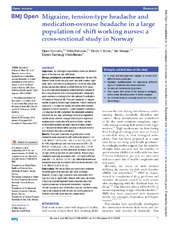| dc.description.abstract | Objectives: To investigate associations between different types of headaches and shift work. Design, participants and outcome measures: Nurses with different work schedules (day work, two-shift rotation, night work, three-shift rotation) participated in a cohort study with annual surveys that started in 2008/2009. In 2014 (wave 6), a comprehensive headache instrument was included in the survey, in which 1585 nurses participated. Headaches were assessed according to the International Classification of Headache Disorders IIIb. Frequent headache (≥1 day per month), migraine, tension-type headache, chronic headache (headache >14 days per month) and medication-overuse headache (chronic headache + acute headache medication ≥10 days last month) comprised the dependent variables. Adjusted (for sex, age, percentage of full-time equivalent, marital status, children living at home) logistic regression analyses were conducted with work schedule, number of night shifts worked last year, number of quick returns (<11 hours in-between shifts) last year, shift work disorder and insomnia disorder as predictors. Results: Frequent headache, migraine and chronic headache were associated with shift work disorder (OR 2.04, 95% CI 1.62 to 2.59; 1.60, 1.21 to 2.12; 2.45, 1.25 to 4.80, respectively) and insomnia disorder (OR 1.79, 95% CI 1.43 to 2.23; 1.55, 1.18 to 2.02; 3.03, 1.54 to 5.95, respectively), but not with work schedule, number of night shifts or number of quick returns. Tension-type headache was only associated with >20 night shifts last year (OR 1.41, 95% CI 1.07 to 1.86). Medication-overuse headache was only associated with insomnia disorder (OR 7.62, 95% CI 2.48 to 23.41). Conclusions: We did not find any association between different types of headaches and work schedule. However, tension-type headache was associated with high number of night shifts. Nurses with sleep disorders (insomnia disorder and shift work disorder) reported higher prevalence of frequent headaches, migraine, chronic headache and medication-overuse headache (only insomnia) compared with nurses not having insomnia disorder and shift work disorder, respectively. | en_US |

